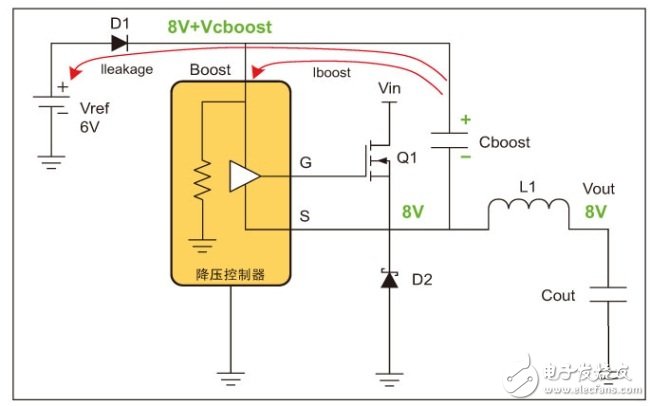Typically, a buck regulator is designed to operate in continuous conduction mode (CCM), which simplifies the calculation of the output voltage and makes system design more straightforward. However, when the system is asynchronous and needs to function under light load conditions, the operation becomes more complex. In such scenarios, the buck converter may switch to discontinuous conduction mode (DCM). In this mode, the duty cycle no longer follows the simple ratio of Vout/Vin but instead depends on a more complicated relationship involving the inductor value, input voltage, switching frequency, and output current.
During normal operation, as shown in Figure 1, the floating gate driver section of the buck controller powers up. The reference voltage, Vref, which helps improve energy efficiency, supplies the NFET gate driver until the diode voltage drops below Vref, allowing the driver to fully activate. At startup, since the output voltage is 0V, the source (S) of the FET (Q1) is also at 0V, ensuring that there is enough voltage to drive the gate (G) of the FET.

Figure 1: Buck regulator during power-up.
Under sufficient load, the system can operate properly in CCM. When the FET turns off, as shown in Figure 2, there is always current flowing through the external FET or D2 into the inductor. This flyback event generates a voltage at the source of Q1, limited by the voltage drop across D2, which results in a negative voltage relative to ground. Meanwhile, the boost capacitor (Cboost) raises the gate voltage, providing enough voltage to drive Q1. The boost capacitor also supplies the source of Q1 with a corresponding negative voltage.

Figure 2: Flyback conditions.
When the average current demand is less than half of the current ripple during light load conditions, the system enters DCM. This occurs because the output current is driven by the reverse recovery of D2. As a result, the output may overshoot due to the slower response time of the control loop, and it might remain at the overshoot level. Additionally, the system could miss pulses due to higher voltages, making the behavior somewhat unpredictable.
There are additional challenges in the circuit configuration we are reviewing. After Q1 turns off, the boost capacitor (Cboost) starts discharging through the boost pin (Iboost), supplying current to any supporting circuits and leaking through D1, as illustrated in Figure 3. In DCM, the extended turn-off time of Q1 causes the charge stored in the boost capacitor to discharge. If the voltage drops to a critical level, Q1 will fail to turn on—typically around 3V, depending on the component. The source of Q1 remains at its regulated voltage (8V in Figure 3, depending on the output load and the Cout value). Q1 turns on again once the output capacitor is fully discharged, and the source voltage drops sufficiently relative to the boost pin voltage (6V - D1) via D1.

Figure 3: Boost capacitor discharging.
In conclusion, designers must carefully evaluate the performance of the switching power supply under all load conditions. Factors such as temperature should be considered, as high temperatures can increase leakage currents. The temperature coefficient of the current flowing into the boost pin is not well known, so low-temperature conditions should also be tested. These results should be included in worst-case simulation scenarios to complete the system evaluation and determine the minimum required capacitance. Careful design practices can also include engineering buffers in calculations.
The solutions to the issues discussed in this article include:
- Increase the value of the boost capacitor (Cboost) to prevent low-voltage discharge events.
- Use gate drivers that reference the ground.
- Modify the design to operate in synchronous mode.
- Adjust the reference voltage connected to D1.
- Replace D1 with a low-leakage Schottky diode.
wall-mounted ev charger,ev charger station 22kw,ev charger 7kw,ev charger type 2
Shenzhen Jiesaiyuan Electricity Co., Ltd. , https://www.gootuenergy.com